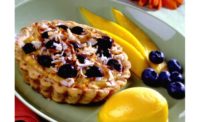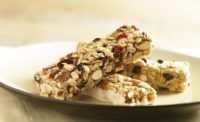With Americans eating more of their meals on the go, it’s no surprise that breakfast is increasingly consumed behind the steering wheel, on the train or at the office.
“Breakfast is one of the fastest-growing categories in the grocery sector right now, and consumers are demanding a lot from their breakfast foods,” says Ryan Barnett, insight manager, food ingredients, Corbion, Lenexa, KS. “Because they are constantly on the go, they’re looking for items that are portable, easy to eat, have some element of perceived healthiness, but most importantly, taste delicious.”
Convenience and quality
According to research from the Almond Board of California, Modesto, convenience tops consumers’ wish lists for breakfast. “This could pose a challenge for manufacturers that may need to consider new formats and functional packaging to provide products that are easily accessible and can be consumed in this manner,” says Molly Spence, director, North America, pointing out that cereal and snack bars are a great solution to this challenge.
Why? “They’re portable, can be formulated to deliver on consumer demands for texture, flavor and protein, and can also tap into clean-label trends when made with all-natural ingredients,” says Spence. “Almonds’ texture and taste functionalities, and many versatile forms, make them an ideal tool for manufacturers developing bar formulations.” She also points out that almonds were tied for the top slot in nuts consumers most associate with energy and granola bars.
Breakfast biscuits and cookies also continue to build an audience. The Mondelēz International Nabisco brand saw its BelVita breakfast biscuits grow by 26.02 percent in dollar sales to $269.1 million for the 52 weeks ending April 17, 2016, per IRI, Chicago. Many other companies have entered this lively product segment.
Erin Baker’s has been baking breakfast cookies since 1994. The brand now encompasses multiple product offerings, including Breakfast Cookie Minis, 1-oz. cookies that have 100 calories, made with whole grains, sweetened with fruit and no preservatives. The full-size cookies come in at 3 oz. each and have 18 grams of whole grains per cookie.
“We see two key trends hitting the breakfast category. The first is not new, but continues to strengthen consistently, and that is healthy, on-the-go breakfast options for the entire family—kids and adults,” says Andy Reichgut, senior vice president, Garden Lites, Jamaica, NY. “Health is defined as clean and simple ingredients, and nutritionally smart. The second is allergen-friendly options and, specifically, gluten-free.”
Garden Lites muffins are free from gluten, nuts and dairy, and are vegetarian-friendly. Also, they clock in at just 120 calories each—and the products are growing at double-digit rates, says Reichgut. Both the Blueberry Oat and Chocolate Muffins include zucchini and carrots. Formulas are structured so that the carrots provide sweetening power, while the zucchini adds necessary moisture.
The frozen breakfast segment is also maturing as a wider range of products—including natural, organic and gluten-free—vie for incremental share. For the 52 weeks ending April 17, 2016, per IRI, Nature’s Path organic waffles grew by 44.53 percent in dollar sales to $6.12 million, and its gluten-free organic Chia Plus waffles grew by 48.36 percent to $1.61 million.
According to data from Technomic, Chicago, the three-year growth of gluten-free mentions on breakfast menus has jumped 153.6 percent. The fastest-growing health claims on breakfast menus over the same period of time include low sodium (up 587.5 percent), low calorie (up 313.6 percent), vegetarian (up 176.3 percent) and vegan (up 104.3 percent).
R&D considerations
To help brands meet these trending demands, machinery and ingredient suppliers are stepping up to the plate. Hinds-Bock Corporation, Bothell, WA, offers machines that can deposit batters into pans or griddles that are custom-designed to support recipes with berries or nuts for added nutrition.
Select grains need additional considerations. Corbion recently released a preservative-free, pre-soaked grain line, “which really helps manufacturers easily incorporate healthy ancient grains and whole grains into their breakfast products, without the mess and time of soaking grains overnight,” says Barnett. The line works well in a variety of breakfast applications, from bagels and breads to bars, and helps brands tick the health box.
As far as convenience, Corbion also offers several freshness products under its Ultra Fresh Sweet Line, which allows manufacturers to keep their packaged baked items, like muffins and doughnuts, flavorful and fresh far longer than the market standard. “Breakfast baked goods can go from dry and stale to moist and resilient,” says Barnett. “Naturally, baked goods that taste better are consumed faster, which results in more repeat purchases and higher sales volume.”
According to Tom Payne, industry specialist, U.S. Highbush Blueberry Council, San Mateo, CA, the ancient grains that have sprouted back onto the market are “a case of what’s old is new again, especially since these grains fit right into our current quest for healthy, wholesome ingredients.” Plus, ancient grains often come with their own historical background, which is appealing to many shoppers, he adds.
Payne notes that blueberries, which provide healthy antioxidants in addition to a sweet, fruity, clean-label flavor, pair well with an array of ancient grains—from oats and amaranth to buckwheat, chia, millet, quinoa, sorghum, teff, kamut, farro, spelt and others.
Blueberries will also remain on-trend, says Payne, since they appeal to consumer demand for “real ingredients” they can recognize on the label.
Breakfast anytime
The fact that consumers want to consume breakfast foods at all hours of the day will shape trends going forward.
The ripple effect is twofold. “This demand for all-day breakfast fare is leading to breakfast-themed entrées, such as egg-topped burgers, breakfast scrambles and breakfast pizzas,” says Barnett.“Additionally, we are seeing more and more consumers reach for traditional breakfast items, such as cereal or a frozen breakfast food, to snack on throughout the day.”
Technomic notes that breakfast crossover items are posting double-digit growth, specifically breakfast Mexican entrées (up 11.9 percent), breakfast pizzas (up 15.7 percent) and breakfast vegetable dishes (up 15.8 percent). These have surpassed traditional starch-based breakfast options in growth: oatmeal as well as biscuits and gravy posted just 6.5 percent growth, and crêpes, cereal and granola all clocked in at less than 2.5 percent growth.
That said, crêpes are one of Technomic’s trends to watch, with higher-end restaurants like Ruth’s Chris Steak House offering crêpes on the dessert menu, likely appealing to consumer demand for customization and an upscale touch.
Additionally, Technomic finds that fast-food chains such as McDonald’s and White Castle have started to offer breakfast foods all day long. The firm chalks this up to consumer demand for breakfast items in the afternoon and evening hours, as well as the restaurants’ attempts to attract customers with high-performing, morning-hour items later in the day.









